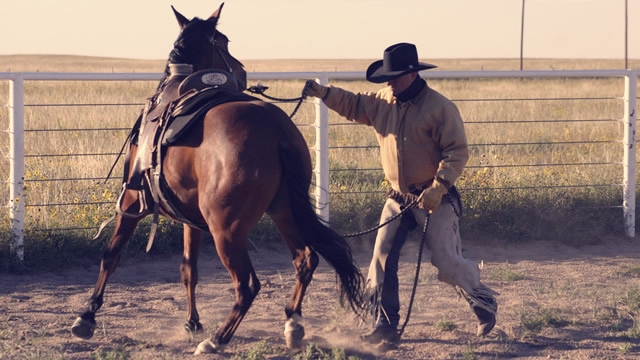Empirical Insight
Creating the Drift
Written by Martin Black This article originally appeared in Eclectic Horseman Issue No.71
There is a lot of attention given to disengaging the hindquarters. Different terminology related to it, different purposes, objectives, and so on.
Most of the hype though seems to center around getting control of the younger horses, at least in my travels, and the focus is on the hindquarters stepping out, inside hind foot stepping in front of the outside hind, etc. That’s all good, but it seems when we focus too much on one area or part of the horse it’s easy to get tunnel vision and lose our peripheral vision. What is going on with the front-end will make a difference in what’s going on with the hind-end, and vice versa. We can focus too much on the head and shoulders and not enough on the hind-end; instead, we need to be aware of the whole horse. More importantly the patterns we lay down as a foundation will determine the horse’s performance as he speeds up. This is going to be true regardless of whether we are talking about controlled speed or uncontrolled speed. This can be observed by seeing what happened before what happened happened. Without going into detail on what happens with the hind-end, (there’s enough said about that) we will address what should be happening in the front-end. The horse can step the hind-end out to the right in a slower turn and the front right foot can pivot bringing the front left back and around as the hind continues going right. This may be useful in cattle handling but if a young horse is scared and gets up any speed he can’t get from the forward motion with speed to the reverse motion without getting slower and rocking back (which isn’t going to happen if he is scared,) with forward drive from the hindquarters. Another scenario we see developed especially in groundwork, is getting the hind-end stepping out while the person is stepping towards it. But if he steps out and around the front end, he creates a pocket, drawing the front feet to step forward and to the inside. Again, the front feet coming forward and to the inside has its place, but if a horse is scared and coming toward you it can be intimidating and the person steps away more, the horse steps forward more and a perpetuating situation is developed. In both of the above scenarios the horse can perform slow and controlled, but with speed, and or panic, he is set up to fail. This has two negative effects when the horse is under pressure. First, the horse learns to come to the person if pressured, and second, with the front-end coming forward one direction it’s easy for the hind-end to come forward and drive too much. You don’t want a scared horse running over the top of you when you are on the ground, and you don’t want him driving forward when you are on his back. A solution to these negative scenarios is to get the hind-end stepping out, and at the same time get the front feet stepping out. It may start out as a forward/sideways movement, but by letting the horse “drift,” he can keep his balance, increase the hind-end stepping out, while outtraveling the front-end to the point that the front feet can be minimized to pivoting around the inside front foot, which is still a forward motion. The important thing to realize is to let the horse “drift,” This can be practiced on the ground. Instead of stepping the hind feet out while the front feet are coming forward and to the inside, step into the shoulder and push it away. If the horse’s nose, or the poll, is tipped to you and the front feet are stepping away while the hind feet are also stepping away farther than the front, this means we have forward motion and can wind him down to pivoting on the inside front foot. What often happens is the person focuses on disengaging the hind-end from the ground, and not wanting to get run over or stepped on by the horse they stay clear of the front feet, and in doing this they step away enough that they draw the front-end to them. If we have forward motion, especially in a panic situation (in the person or horse), it is important to realize what’s happening with not only the hind feet but also the front feet and look for the “drift” before the hind steps out or the front steps in and forward. Any direction we can move our horse will likely be useful somewhere. We just need to be careful we don’t get him too patterned and not have a balance and variety of maneuvers. If he is going to be patterned somewhere, I would rather see the positive outcome when he gets scared, not a negative one. This article originally appeared in Eclectic Horseman Issue No.71


